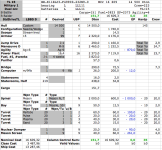The Rider/Tender vs. Dreadnought issue was brought up on another thread with someone making the suggestion of giving some specialized Riders a J-1 capability. This got me thinking about the following naval tactics:
The tactic would be as follows:
The Riders would still have more offensive capability than a full Battleship (though not quite as much as a pure non-Jump Rider), and would have the additional advantage that their Tender is safe from harm during the battle (and effectively hidden as to location). The Jump-Riders would still be able to retreat if necessary. Further, since an empty hex is a cubic parsec of space (which is a HUGE volume in which the Tender is located "somewhere"), the Tender is highly unlikely to be accidentally found, and even if the rules are interpreted to mean that a jumping ship's general direction and destination (outbound or inbound) can be determined from "Jump-flash", it will not help anyone trying to track the intruder as there would be no way to know where within that huge volume of space the Tender is actually located. Nor would anyone be able to detect signals or signatures from it for months or years due to light-lag.
What are peoples thoughts on the implications of the tactic?
Viable?
Misguided?
Possible, but with details needing modification?
What if Fleet Tenders carried a squadron of Riders with J-1 capability (and fuel for either 1 Jump or 2 successive jumps)? This would still leave much more free displacement-volume within the rider than a comparably sized J-4 Battleship or Dreadnought to be allocated to weapon systems.
The tactic would be as follows:
- J-4 Fleet Tender Jumps into an EMPTY HEX adjacent to the target system
- "Jump-Riders" jump into the target system and engage in operations (recon, battle, etc)
- Depending on the fuel load (1 or 2 jump capacity), they jump out during or after operations or battle back to the adjacent hex location of their Tender.
What are peoples thoughts on the implications of the tactic?
Viable?
Misguided?
Possible, but with details needing modification?


